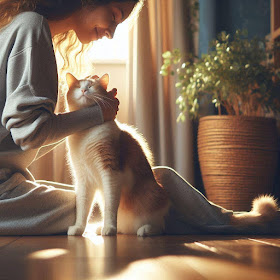What Your Cat's Actions Really Mean
Cats are mysterious animals, full of behaviors that make them adorable yet sometimes headscratchers, even for seasoned cat owners. Knowing precisely what your cat is trying to tell you through their actions is where forming a strong bond and ensuring their well-being lies. Herein, we review common cat behaviors and what they really mean so that you can better decode your feline friend's mysterious ways.
Why Feline Behaviour is Important to Understand Cats have been described by many as standoffish or independent, but the reality is that cats, too, communicate with us in subtle and nuanced ways. Done by giving it some time with its body language, vocalizations, and other habits, you can best meet their needs and deepen your relationship. Whether it's that your cat purrs at a contented state or all of a sudden zooms around the house, there's always a reason for such behaviour.
Common Cat Behaviors and Their Meanings
1. Purring: More Than Just Contentment
This usually occurs when your cat simply curls up onto your lap and starts to purr. The assumption may be that your cat is content, yet a lot of times, there is much more going on behind the scenes. Cats could purr at such a time when they are nervous or even in some sort of pain. Some studies have suggested that cats purr as a way of soothing themselves, speeding up their calming process or healing.
2. Kneading: A Sign of Comfort
The most frequent kind of kneading behavior a cat performs involves tending to press their paws in and out against a soft surface, such as a blanket or your lap. Their cats often demonstrate this behavior when they are kittens, kneading mother's bellies, stimulating her to secrete milk. As adults, cats act this way when they're at ease and comfortable; therefore, it would seem that they're reverting to some sort of time where they felt safe and cared for.
3. Zoomies: The Post-Nap Energy Burst
If you've ever seen your cat suddenly dash around the house for no apparent reason, you've witnessed the "zoomies." This behavior, also known as Frenetic Random Activity Periods (FRAPs), is usually a sign that your cat is releasing pent-up energy. Zoomies are especially common in indoor cats who may not get as much physical activity as they would in the wild.
4. Head-Butting: Marking Their Territory
When your cat rubs or bumps their head against you, they're engaging in a behavior known as "bunting." This is simply a means for them to mark you with scent-to let others know you're part of their territory. It is also a direct signal of affection and trust. With this head-butting, your cat is only able to show them that they can feel safe and comfortable around you.
5. Tail Language: Reading the Signals
A cat's tail speaks volumes. It is one of the most speaking features about a cat's mood. For example:
- **Upright Tail**: Confident, happy.
- **Puffed-Up Tail**: Threatened or scared.
- **Twitching Tail**: Irritated or excited.
This should allow you to understand what exactly is going on inside your cat's mind and know how to handle things properly.
6. Slow Blinking: A Gesture of Love
One of the sweetest and most subtle behaviors you might observe is your cat giving you a slow blink. Referred to often as a "cat kiss," it is one sure way for a cat to show they trust you. If a cat gives you a slow blink, then this is a sign that they feel safe in your presence and are showing affection.
7. Hiding: A Need for Security
By nature, the domestic cat is a cautious animal and will retreat to some quiet, safe retreat when it is getting too stressed or pressurized. So, if your feline is hiding more than normal, it may just mean stress, illness, or just some time out for your pet. Of course, you should respect their need for privacy but take proper monitoring to exclude pathology.
How to React to Your Cat's Behaviors Understanding your cat's behaviors is the first step, but knowing how to respond to them equally as important. Here are a few tips:
Purring: If your cat is purring and seems anxious, try to identify any stressors in their environment and remove them.
Kneading: Your cat is kneading for comfort and should not be stopped from doing so. Soft blankets and pillows may be made available to them for added comfort.
Zoomies: Plenty of toys should be made available for your cat to run around with. This will enable regular exercises that will burn up any excess energies.
Head-Butting: Pet your cat back or reassure them in a soft voice.
- **Tail Signals**: Change with the mood through their tail language—leave them alone if they are grumpy or they want to play.
- **Slow Blinging**: Just return the slow blink to communicate to your cat that you also love and trust them.
- **Hiding**: Offer your cat a safe quiet place it can retreat to, but if this persists, see a veterinarian.
**Conclusion: Building a Stronger Bond Through Understanding
By taking the time to understand your cat's behaviors, you will not only be improving the quality of its life but also your bond with it. Cats, while they may be independent animals, very much rely on us to notice their needs and treat them with kind consideration. The next time your cat acts out, you will more clearly understand what your pet is trying to tell you.
For more information and tips about cat care and behavior, sign up for our newsletter or follow us on social media. Share your cat's strange behaviors in the comments below-we'd love to hear from you!









